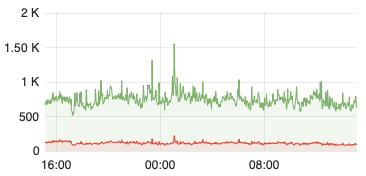Transaction pooling in 4844
How to not go boom, in theory
15 April 2023
ETHTokyo
Péter Szilágyi
Go Ethereum Lead

What the heck is 4844?
Before 4844: Layer-2 chains on top of Ethereum
Layer-2s are semi-independent blockchains
- Run transactions concurrently to Ethereum
- Collect results and create small commitments
- Submit the commitments to Ethereum as proofs
Layer-2 chains potentially scale Ethereum
- Commitments are submitted periodically ⇒ lower per-transaction fees 🙂
- Commitments can be challenged a while ⇒ lower overall chain security 🫠
- Commitments are useless after that time ⇒ wasted mainnet chain space 🥴
After 4844: Layer-2 chains on top of Ethereum... cheaper
Data lives forever on Ethereum ⇒ adding new data is expensive
- Transaction input data costs 16 gas per byte ⇒ 128KB data ≈ 0.05 ETH @ 25 gwei
- Contract storage costs 20.000 gas per 32 ⇒ 128KB data ≈ 2.05 ETH @ 25 gwei
- Receipt log data costs 8 gas per byte ⇒ 128KB data ≈ 0.025 ETH @ 25 gwei
Commitments don't need to live forever ⇒ archiving them is insanity
EIP-4844 introduces transactions with 128KB ephemeral data blobs
- Blobs are dropped after a month¹ ⇒ long term storage usage is zero²
- Separate pricing, similar to 1559 ⇒ DoS protected, may cost 1 wei / byte³
EIP-4844: Preferential treatment of layer-2s...

Ethereum users and layer-2 operators are separated
- Users pay the
basefee for data ⇒ large txs are expensive
- Layer-2s pay the
datafee for attached blobs ⇒ large txs are cheap
Is is fair that layer-2s can transact cheaper?
- Blobs consume data gas ⇒ no competition for execution gas
- Blobs pay in data fee ⇒ no upwards force on the base fee
EIP-4844 enables layer-2s while reducing costs for others
Blob-transaction pooling
Transaction size


 propagations/sec on mainnet, 50 peers, 24h
propagations/sec on mainnet, 50 peers, 24h
Ethereum transactions are small (<1 KB)
- Propagation is achieved via broadcasting to
sqrt peers (red)
- Announced to other peers for degenerate networks (green)
Blob transactions are 128KB+ (potentially up to 512KB or 2MB)
- Peers must only receive them once ⇒ no broadcasts, request on demand
- Concurrent fetches must not overload ⇒ announce tx type and size too (
eth/68)
Block space
Ethereum blocks fit many transactions (up to 1428 @ 30M gas)
- Churn rate of the transaction pool is high ⇒ disk persistence is problematic
- Limited transaction pool capacity (RAM) ⇒ resend issues and eviction attacks
Data blobs per block are aggressively capped (4 or 16)
- Persistency latency becomes acceptable (8 writes in 12 sec)
- Capacity can be increased significantly (80K txs @ 10GB)
- Evicting legit transactions becomes unreasonable*
Artificial churn (i.e. pool wars) must be avoided
Purpose of transactions
Ethereum transactions are supposed to be generic
- Bad practice to restrict based on anticipated use cases
- Replacements and cancellations are expected to work
Layer-2s are meant to use blobs to commit proofs
- Commitments are independent of Ethereum, cannot become stale
- No reason for cancellations, layer-2s need to commit regularly
- No reason for replacements, apart from fee adjustments
Cost of replacements
Ethereum transactions can be replaced (1 wei start, 10% fee bump)
- Transactions are small ⇒ propagating replacements is cheap
- Validations are quick ⇒ processing replacements is cheap
Blob transactions are expensive to replace
- Re-propagating a blob transaction costs bandwidth (
N*128KB)
- Re-validating a blob transaction costs processing time (
N*2ms)
Replacements must be penalized (1 gwei start, 100% fee bump)
Cost of cancellations
Ethereum transaction can be cancelled
- A contract call can be cancelled via a self transfer
- Subsequent transactions can be cancelled via account sweeps
Cancelling a blob transaction is a DoS vector
- Replacements mustn't invalidate propagated future ones
- Nonce gaps in blob transaction sequences are disallowed
- Pooled blob transactions exclude pooled non-blob ones
Relevancy of locality
Ethereum transactions can be tracked as local
- Pre-1559, locals permitted 0 gas price for miners 🙃
- Locals are exempt from evictions due to out-pricing 😊
- Locality introduces a new dimension into pooling algos 🫠
Locality is less relevant for blob transactions
- 1559's basefee and 4844's datafee remove fee games
- Large disk persistency reduces reason for eviction protection*
Genericity of transactions
Ethereum transactions are always supersets*
- Access list transactions extend Homestead ones
- 1559 dynamic fee transactions extend access list ones
Blob transactions should be standalone
- Blobless blob transactions are 1559 transactions
- 0-blob transactions break low-churn, size uniformity, predictability
- Rejecting them in the pool but accepting in-protocol (blocks) breaks during reorgs
Lifecycle of transactions
Ethereum transactions get stored fully on the chain
- Upon inclusion, a transaction is dropped form the pool
- Upon reorg, a lost transaction is resurrected back into the pool
Blob-transaction blobs are discarded from the chain
- Mini reorgs cannot resurrect transactions into the pool
- Blobs need to be stored until they are finalized and discardable
Points of entry
Ethereum transactions are fully bundled in a block
- Downloaded blocks via sync contain even hidden MEV txs
- Propagated blocks via beacon payloads contain even hidden MEV txs
Blob transactions are not fully bundled in a block
- Reorg of synced blocks will be unable to resurrect blobs
- Beacon clients must provide the blobs in the new payload API calls
Why all the constraints?
Geth's prototype benchmarks
Legacy pool is capped at 4K transactions (@ 200MB RAM, no disk usage)
- Blob pool could be capped at 80K transactions (@ 20MB RAM, 10GB disk) 😊
Legacy pool's post-block processing is ~1ms (@ 4K txs, 1D fees)
- Blob pool's post-block processing in ~75ms (@ 40K txs, 2D fees) 🫠
Everything's a tradeoff. Constraints are good. Metrics are king.
Thank you

Use the left and right arrow keys or click the left and right
edges of the page to navigate between slides.
(Press 'H' or navigate to hide this message.)











 propagations/sec on mainnet, 50 peers, 24h
propagations/sec on mainnet, 50 peers, 24h




















